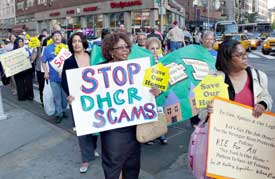NYC tenants march from Stuyvesant Town to Union Square
By
G. Dunkel
New York
Published May 31, 2007 12:01 AM
Over 7,000 people from 90 tenants’ groups, labor unions, homeless
organizations and AIDS activists working on housing joined the New York Is Our
Home! Coalition for a “Hands around Stuyvesant Town” demonstration
on May 23. This diverse population held hands and marched to protest the
“flipping” of relatively low-rental housing to luxury apartments in
New York City.
|
New York, May 23.
WW photo: G. Dunkel
|
Ed Ott, chair of the Central Labor Council in New York City, kicked off the
rally with these words: “The price of housing in this city is effectively
theft for working and working middle class people.” He went on to say
that housing and other living costs in this city are an increasingly
intolerable burden for working families, even with two incomes.
Every tenant in New York City who works for a living is worried about
preserving decent, affordable housing. The Retirees Chapter of AFSCME’s
District Council 37, CWA 1180, SEIU, UFT, which represents the primary and high
school teachers in New York City, Teamsters Local 808 and a number of other
city unions had contingents in the line and in the march to Union Square that
followed. Acorn and the Working Families Party had members pulling the
demonstration together.
Tenant groups from all over the city—in particular, the Lower East Side,
Chinatown, the South Bronx, Bedford-Stuyvesant in Brooklyn, and the West Side
of Manhattan—had sizable contingents. The homeless groups made the point
that high rents mean more people on the streets, which official statistics bear
out.
Composed of African Americans, Latin@s, and whites, a strong contingent from
Starrett City in south Brooklyn raised the issue of flipping the 6,000
apartments there from affordable to luxury. There were two contingents from the
Chinese community—the Chinese Progressive Association and Asian Americans
for Equality. People coming from work were dressed in jeans and uniforms, as
well as business suits.
Stuyvesant Town has around 8,000 apartments in 100 buildings and occupies 80
acres between 14th and 20th Sts., and between First Ave. and Avenue C on the
eastern edge of Manhattan. Tishman Speyer Properties recently bought it,
together with Peter Cooper Village just to its north, from the Metropolitan
Life Insurance Co. for $5.4 billion and now advertises “luxury
rentals.”
Met Life originally had it built in the mid-1940s for returning World War II
veterans with aid from the city. Tishman Speyer seems to be betting that enough
of the “old” tenants with stabilized rents—about one-third
the level of current market rates—will be forced to move out. Then
Tishman Speyer will charge $4,000 or more a month for a two-bedroom
apartment.
Even if a minimum-wage earner could find an apartment in Stuyvesant Town for
what the Housing and Urban Development department calls a “fair market
rate”—currently $1,069, they would have to work 122 hours a
week—more than three full-time jobs—to afford it. This is the
reality that lies behind the fact that more than 100,000 families in New York
City pay more than 50 percent of their monthly income for housing.
The New York Is Our Home! Coalition has a clear set of demands: repeal vacancy
decontrol, the law that allows landlords an unlimited increase in rents when
tenants move out; reinstate full subsidies to public housing; preserve
Mitchell-Lama and Section 8 housing, which are different government programs
for providing affordable housing; and limit rent payments for New Yorkers
living with aid to 30 percent of their income.
The host of politicians who spoke were judged on whether or not they supported
these demands. Many of the people listening to the speeches follow local
politics closely and had no qualms about telling politicians that they were
being watched and judged.
In New York City two out of every three people rent homes. In the rest of the
country, two out of three own homes. A law regulating New York rents was passed
for the first time in 1920 and different versions of it have been in force ever
since.
New York City also still has the largest amount of rental housing under some
form of rent control of any U.S. city. If the landlords in New York can do away
with rent control, they will transfer additional billions of dollars a year
from workers to their profits. They will also discourage tenant groups
throughout the country from struggling for this kind of protection.
Articles copyright 1995-2012 Workers World.
Verbatim copying and distribution of this entire article is permitted in any medium without royalty provided this notice is preserved.
Workers World, 55 W. 17 St., NY, NY 10011
Email:
[email protected]
Subscribe
[email protected]
Support independent news
DONATE


